|
|
|
Sort Order |
|
|
|
Items / Page
|
|
|
|
|
|
|
| Srl | Item |
| 1 |
ID:
184788
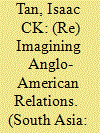

|
|
|
|
|
| Summary/Abstract |
From December 1922 to February 1929, two Englishmen, Lieutenant-Colonel John Champion Faunthorpe and Arthur Stannard Vernay, led six expeditions to the Indian subcontinent to collect animal specimens for the newly refurbished American Museum of Natural History in New York City. This article argues that the Vernay-Faunthorpe Expeditions were an expression of a new form of Anglo-American relations that engaged the language of scientific knowledge in maintaining Western hegemonic influence in the early twentieth century. Inspired by genuine scientific objectives as much as by aspirations to reassert Western hegemony in a time of rising nationalism and declining imperial influence, this timely collaboration reimagined imperialism beyond territorial expansion, but in the discursive spaces of indigenous nature and wildlife exhibitions.
|
|
|
|
|
|
|
|
|
|
|
|
|
|
|
|
| 2 |
ID:
184789
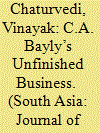

|
|
|
|
|
| Summary/Abstract |
The purpose of this essay is to introduce C.A. Bayly’s ‘The Spirits of Europe and India’s Twentieth Century’, a paper that was written in 2011 for a workshop at Stanford University titled ‘Civility at the Limit of the Political’. The paper was circulated to the workshop participants and discussed, but it was largely forgotten. The following year Bayly’s Recovering Liberties (2012) was published as part of Cambridge University Press’ ‘Ideas in Context’ series, and I am assuming that his priority was elsewhere—and for good reason. He had once told me that he normally gave himself a day or two to recover after finishing a book before embarking on his next project. He explained that it was often difficult to start writing after taking a break, so the best thing to do was continue writing. I doubt that this was the full story, especially as anyone who knew Bayly’s work patterns also knew that he was involved in multiple writing projects at the same time. At one point I had asked him how many books he had researched or planned. He said my question was a difficult one but reflected that the most accurate answer was four. He added a caveat that he was also preparing for projects in what he anticipated were going to be his ‘declining years’ in which he could sit in his room in St. Catherine’s College or at the Centre of South Asian Studies in Cambridge without having to travel to archives. On 18 April 2015, Bayly died in Chicago, where he held the Vivekananda Visiting Professorship at the University of Chicago.
|
|
|
|
|
|
|
|
|
|
|
|
|
|
|
|
| 3 |
ID:
184794


|
|
|
|
|
| Summary/Abstract |
Based upon fieldwork at India’s National Institute of Mental Health and Neurosciences (NIMHANS), I trace the contours of hysteria as an enduring, albeit informal, analytic that continues to disturb neuropsychiatric reductionism within psychiatry. I argue that at this historical moment, the political and economic demand for singular identities out of more porous cultural life-worlds (e.g. ethnic, religious, linguistic, occupational) produces clinical subjects incapable of nuance and flexibility, hastening a host of possessive, literalist, legalist and ‘hysteric’ symptoms that overtake India’s most vulnerable modern subjects, fuelling the sense of a crisis in search of a pharmaceutical solution to a psychopathological diagnosis.
|
|
|
|
|
|
|
|
|
|
|
|
|
|
|
|
| 4 |
ID:
184790


|
|
|
|
|
| Summary/Abstract |
Several anthropological essays in this issue of South Asia, each engaging the figure of hysteria, are reviewed through the relation of phenomena typified as hysterical to accusations of these being counterfeit or ‘duplicate’. A conceptual vocabulary to analyse the essays draws from the author’s work on India’s Aadhaar biometric identification platform as a means to transform a nation into a database and govern through an array of technical practices termed ‘de-duplication’. De-duplication emerges as a useful way to attend to the stakes in the enunciation or refusal of the hysterical symptom.
|
|
|
|
|
|
|
|
|
|
|
|
|
|
|
|
| 5 |
ID:
184787
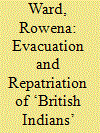

|
|
|
|
|
| Summary/Abstract |
In 1940, the Indian population resident in Japan was estimated at over 500. With the potential for war with Japan increasing, the British embassy in Tokyo advised locally resident British subjects to leave in October 1940 and again in February 1941. However, some, including a number of Indians, chose not to leave. This article considers the evacuation of the Indian population from Japan before December 1941 as well as those who departed as part of the wartime Anglo-Japanese Civilian Exchange. In doing so, it discusses the use of the SS Anhui to evacuate British subjects and also the lack of safe conduct for the City of Paris, which carried the Indian repatriates back to Bombay.
|
|
|
|
|
|
|
|
|
|
|
|
|
|
|
|
| 6 |
ID:
184795


|
|
|
|
|
| Summary/Abstract |
In 2011, Sri Lanka experienced a wave of ‘grease devil’ attacks—men covered in grease assaulting women. In minority Tamil and Muslim areas, these incidents provoked vigilantism and clashes between locals and the police and the military. This essay examines these incidents through situating them in histories of intense militarisation and current post-war anxieties for ethnic minorities in Sri Lanka. Drawing inspiration from anthropologist James Siegel’s work, it analyses how subterranean forms of violence, currently undertaken by the state, as well as longer histories of political violence unforgotten but publicly disallowed, resurface via proxy figures and a more generalised sense of menace. This history and ongoing militarisation and securitisation produce both ethnically differentiated landscapes, and mark and shape desires in fearful and securitised ways.
|
|
|
|
|
|
|
|
|
|
|
|
|
|
|
|
| 7 |
ID:
184791
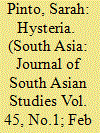

|
|
|
|
|
| Summary/Abstract |
Ways of mapping mental illness in the world involve stories about history, time and qualities of knowledge. This paper explores the history of hysteria as a South Asian story. With a South Asia-centred history of the contemporary critical concept of cultural translation, this paper observes not only hysteria’s long South Asian history, but the colonial emergence of a defining narrative—the equation of hysteria to spirit possession, a naturalised conceptual arrangement that superimposed upon a long history of medical encounters racialised ideas about epistemological difference.
|
|
|
|
|
|
|
|
|
|
|
|
|
|
|
|
| 8 |
ID:
184793
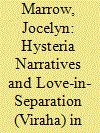

|
|
|
|
|
| Summary/Abstract |
This article examines first-person narratives of a hysteria-like illness, referred to locally as ‘clenched teeth (daant lag gaya)’. In Varanasi, India, the distinguishing sign of ‘clenched teeth’ is a tightly closed mouth, and symptoms involve seizure-like or fainting behaviours. I show how North Indian women improvised upon expressive genres of love-in-separation (viraha) to narrate their experiences of this illness. Drawing upon the symbolic structure of viraha to explain bodily signs and symptoms, patients of ‘clenched teeth’ asserted they were women who loved so deeply and steadfastly that they could not help but experience distress when separated from the person they adore. Simultaneously, these ad-hoc narratives concealed a traumatic kernel—an unbridgeable asymmetry between the sufferer and her beloved—that rendered the emotion conveyed not only that of love, but also of anger and resentment.
|
|
|
|
|
|
|
|
|
|
|
|
|
|
|
|
| 9 |
ID:
184784
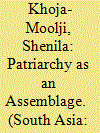

|
|
|
|
|
| Summary/Abstract |
This article contributes to recent debates about nuancing the idea of ‘patriarchy’ by drawing on Deleuze and Guattari’s notion of assemblage. It provides an account of patriarchy as a contingent yet persistent effect of human and material interactions wherein some molar forces aggregate and territorialise social relations around specific notions of womanhood, while molecular flows evade them. The particular set of interactions that this paper considers are configured through and around Qandeel Baloch, a social media celebrity from Pakistan, who was asphyxiated by her brother in 2016. In life, Baloch evaded several normative boundaries prescribed for middle-class Pakistani women. Riding the wave of social media expansion and an attentive youthful audience, she monetised male lust by transforming her body into a commodity, challenged self-appointed arbiters of religion, and mocked politicians. In death, she has been re-territorialised by mainstream media to conform to the social codes that bolster male domination. At the same time, she has been de-territorialised by feminist collectives that have produced their own normativity (or molarity) by erasing Baloch’s ambiguities and pronouncing her a feminist icon. Examining patriarchy as an assemblage of forces directs our attention to such heterogenous, even contradictory, movements wherein some pathways—male domination—are more heavily trafficked than others.
|
|
|
|
|
|
|
|
|
|
|
|
|
|
|
|
| 10 |
ID:
184792


|
|
|
|
|
| Summary/Abstract |
Following in the wake of the People’s War (1996–2006) and the 2015 earthquakes, donor-funded projects supporting community mental health programmes and psychosocial counselling have proliferated in Nepal. This article explores one outcome of the expansion of ‘psy’: the transformation of ghosts and spirits, bhut-pret, into a psychosomatic affliction of repressed emotion and unconscious desire. By engaging theories of translation, I approach interventions for cases of ‘mass conversion disorder’ and the therapeutic encounters, contestations and uncertainties that coalesced around them as a lens into the politics of psychic life currently under way in Nepal.
|
|
|
|
|
|
|
|
|
|
|
|
|
|
|
|
| 11 |
ID:
184785
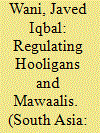

|
|
|
|
|
| Summary/Abstract |
In 1938, a communal conflict took place in the city of Bombay. This confrontation between Hindus and Muslims flared into large-scale violence. During the riots, the home minister of the provincial government invoked a combination of laws such as Section 144 of the Code of Criminal Procedure and instituted curfews to control the situation. As a result, hundreds of inhabitants of the city were arrested. The purpose of this article is threefold. Firstly, it will highlight how communal conflict in the late colonial period would often begin over trivial issues but could easily expand into large-scale riots influenced by metapolitical concerns. Secondly, moments of ‘disorder’ facilitated the administrative urge to institute extraordinary laws like Section 144 and curfews. And thirdly, the invocation of extraordinary laws was justified in reference to various problem categories like mawaalis and hooligans in this case. Overall, the article will show that the provincial government led by Indians continued the colonial art of governance by resorting to repression as a significant tool to deal with political unrest.
|
|
|
|
|
|
|
|
|
|
|
|
|
|
|
|
| 12 |
ID:
184786


|
|
|
|
|
| Summary/Abstract |
This article attempts a pre-history of the publication of The Transfer of Power documents through the 1960s. In doing so, it: (1) throws light on the external reasons and internal motivations at play for this pivotal production; (2) presents the other options considered and the formula eventually followed; and (3) illustrates the method by which the officials, librarians and historians involved went about including, excluding and editing the documents concerned. Through it all, the article seeks to trace the timeline, tease out the creative tensions and tackle the political imperatives of this attempt to influence historiography on the original transfer of power. Drawing upon official archives behind the emergence of this archival corpus, it concludes its analyses of this exercise of the late 1960s by drawing parallels with the emotions of the late 1940s and finds that the pride and prejudice displayed then fed the principles and pragmatism exhibited now.
|
|
|
|
|
|
|
|
|
|
|
|
|
|
|
|
|
|
|
|
|